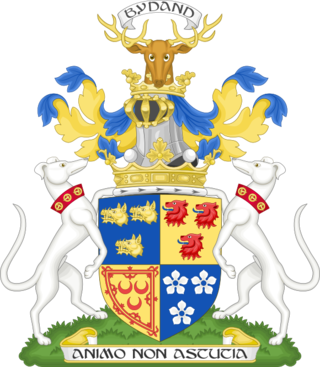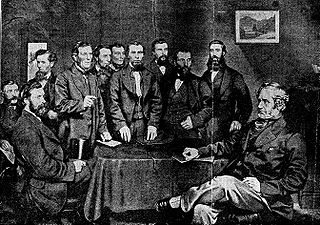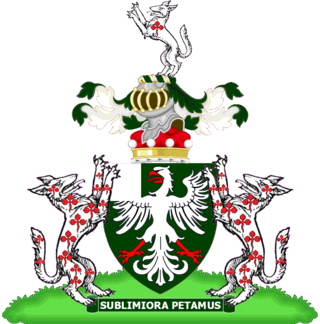Related Research Articles

Marquess of Huntly is a title in the Peerage of Scotland that was created on 17 April 1599 for George Gordon, 6th Earl of Huntly. It is the oldest existing marquessate in Scotland, and the second-oldest in the British Isles; only the English marquessate of Winchester is older. The Marquess holds the following subsidiary titles: Lord Gordon of Strathaven and Glenlivet and Earl of Aboyne, and Baron Meldrum, of Morven in the County of Aberdeen.

Baron Byron, of Rochdale in the County Palatine of Lancaster, is a title in the Peerage of England. It was created in 1643 by letters patent for Sir John Byron, a Cavalier general and former Member of Parliament. The peerage was created with remainder to the heirs male of his body, failing, to his six brothers: Richard, William, Thomas, Robert, Gilbert, and Philip, and the heirs male of their bodies. Lord Byron died childless and was succeeded according to the special remainder by his next eldest brother Richard, the second Baron.

Earl of Ducie is a title in the Peerage of the United Kingdom. It was created in 1837 for Thomas Reynolds Moreton, 4th Baron Ducie.
Viscount Allendale, of Allendale and Hexham in the County of Northumberland, is a title in the Peerage of the United Kingdom. It was created on 5 July 1911 for the Liberal politician Wentworth Beaumont, 2nd Baron Allendale. The title of Baron Allendale, of Allendale and Hexham in the County of Northumberland, had been created in the Peerage of the United Kingdom on 20 July 1906 for his father, the Yorkshire mining magnate and Liberal Member of Parliament, Wentworth Beaumont. The first Viscount's son, the second Viscount, notably served as Lord Lieutenant of Northumberland between 1949 and 1956. As of 2017 the titles are held by the latter's grandson, the fourth Viscount, who succeeded his father in 2002.

Baron Macdonald, of Slate in the County of Antrim, is a title in the Peerage of Ireland. It was created in 1776 for Sir Alexander Macdonald, 9th Baronet, of Sleat. The Macdonald family of Sleat descends from Uisdean Macdonald, also known as Hugh of Sleat, or Hugh Macdonald, who was an illegitimate son of Alexander Macdonald, Earl of Ross. On 28 May 1625, his great-great-great-great-grandson Donald Gorm Og Macdonald was created a baronet, of Sleat in the Isle of Skye in the County of Inverness, in the Baronetage of Nova Scotia. The baronetcy was created with remainder to heirs male whatsoever and with a special clause of precedence which provided that it should have precedency over all former baronets.
Baron Hollenden, of Leigh in the County of Kent, is a title in the Peerage of the United Kingdom. It was created in 1912 for Samuel Morley, who had previously served as Governor of the Bank of England. He was the son of Samuel Morley and Rebekha Maria Hope and the elder brother of Arnold Morley. Lord Hollenden was succeeded by his son, the second Baron. He was High Sheriff of the County of London in 1917. In 1923 he assumed by deed poll the additional surname of Hope. On his death the title passed to his nephew, the third Baron. He was the only son of the Hon. Claude Hope Hope-Morley, younger son of the first Baron. Lord Hollenden was an Alderman of the City of London. As of 2014 the title is held by his son, the fourth Baron, who succeeded in 1999.

Baron Hazlerigg, of Noseley in the County of Leicester, is a title in the Peerage of the United Kingdom. It was created in 1945 for Sir Arthur Hazlerigg, 13th Baronet. He had previously served as Lord Lieutenant of Leicestershire. As of 2023 the title is held by his great-grandson, the fourth Baron, who succeeded his father in 2022.

Baron Sandhurst, of Sandhurst in the County of Berkshire, is a title in the Peerage of the United Kingdom. It was created on 28 March 1871 for the soldier Sir William Mansfield, Commander-in-Chief of India between 1865 and 1870 and Commander-in-Chief of Ireland between 1870 and 1875. He was the grandson of Sir James Mansfield, Solicitor-General and Chief Justice of the Common Pleas. Lord Sandhurst's eldest son, the second Baron, was a Liberal politician and also served as Governor of Bombay. On 1 January 1917 he was created Viscount Sandhurst, of Sandhurst in the County of Berkshire, in the Peerage of the United Kingdom. However, he had no surviving male issue and on his death in 1921 the viscountcy became extinct. He was succeeded in the barony by his younger brother, the third Baron. As of 2021 the title is held by the latter's great-grandson, the sixth Baron, who succeeded his father in 2002. He is a barrister and judge and was elected to a hereditary-peers' seat in the House of Lords in 2021.

Baron Strathcarron, of Banchor in the County of Inverness, is a title in the Peerage of the United Kingdom. It was created on 11 January 1936 for the Liberal politician Sir Ian Macpherson, 1st Baronet. He had already been created a baronet, of Drumalban on 26 April 1933. As of 2017, the titles are held by his grandson, the third Baron, who succeeded his father in 2006.
Baron Strathalmond, of Pumpherston in the County of Midlothian, is a title in the Peerage of the United Kingdom. It was created on 18 February 1955 for the businessman Sir William Fraser. He was chairman of the Anglo-Persian Oil Company from 1941 to 1956. His son, the second Baron, was managing director of the Kuwait Oil Company and a director of BP and later chairman of Govan Shipbuilders. As of 2017 the title is held by the latter's son, the third Baron, who succeeded in 1976.

Baron Penrhyn is a title that has been created twice. The first creation came in the Peerage of Ireland in 1783 in favour of Richard Pennant, who had previously served as a Member of Parliament for Petersfield and Liverpool. This creation became extinct on his death in 1808. The next creation came in 1866 in the Peerage of the United Kingdom when the Conservative politician Edward Douglas-Pennant was created Baron Penrhyn, of Llandegai in the County of Carnarvon. He had previously represented Carnarvon in the House of Commons and also served as Lord Lieutenant of Caernarvonshire. He was granted the estate of his father-in-law on the condition that he accepted his wife's maiden name, Pennant. Lord Penrhyn was the younger brother of The 17th Earl of Morton. In 1833 he had married Juliana Isabella Mary Pennant, eldest daughter and co-heiress of George Hay Dawkins-Pennant of Penrhyn Castle and in 1841 he assumed by Royal licence the additional surname of Pennant.

Baron Biddulph, of Ledbury in the County of Hereford, is a title in the Peerage of the United Kingdom. It was created on 1 August 1903 for the banker and politician Michael Biddulph. He was a partner in the London banking firm of Cocks, Biddulph and Co and also sat in the House of Commons for Herefordshire as a Liberal from 1868 to 1885 and for Ross from 1885 to 1900 as a Liberal Unionist. His father Robert Biddulph had previously represented Hereford in Parliament while his younger brother Sir Robert Biddulph was Governor of Gibraltar. As of 2017 the title is held by the first Baron's great-great-grandson, the fifth Baron, who succeeded his father in 1988. In 1978 he assumed the additional surname of Maitland, which is the maiden surname of his mother, Lady Mary Helena Maitland, granddaughter of Ian Colin Maitland, 15th Earl of Lauderdale. She is a Patroness of the Royal Caledonian Ball.
Baron Catto, of Cairncatto in the County of Aberdeen, is a title in the peerage of the United Kingdom. The only hereditary peerage newly conferred during the reign of King Edward VIII, the barony was created on 24 February 1936 for the businessman, banker and public servant, Sir Thomas Catto, 1st Baronet. He had already been created a baronet, of Peterhead, on 5 July 1921. As of 2018 the titles are held by his grandson, the third baron, who succeeded his father in 2001.

Baron Croft, of Bournemouth in the County of Southampton, is a title in the Peerage of the United Kingdom. It was created on 28 May 1940 for the Conservative politician Sir Henry Page Croft, 1st Baronet. He had already been created a baronet of Knole in the Borough of Bournemouth in the County of Southampton in the Baronetage of the United Kingdom on 28 February 1924. Croft was the grandson of Reverend Richard Croft, third son of Dr. Sir Richard Croft, 6th Baronet, of Croft Castle. As of 2010 the titles are held by the first Baron's grandson, the third Baron, who succeeded his father in 1997.

Baron Colgrain, of Everlands in the County of Kent, is a title in the Peerage of the United Kingdom. It was created in 1946 for the Scottish banker Colin Campbell. He was President of the British Bankers' Association from 1938 to 1946. As of 2017 the title is held by his great-grandson, the fourth Baron, who succeeded his father in 2008. Since 2017 he has been one of the 92 hereditary peers chosen to remain in the House of Lords under the House of Lords Act 1999.

Gordon Macdonald, 1st Baron Macdonald of Gwaenysgor was a British Labour Party politician and Newfoundland's final British governor as well as the last chairman of the Commission of Government serving from 1946 until the colony joined Confederation in 1949 and became a province of Canada.

Viscount Hewart, of Bury in the County Palatine of Lancaster, was a title in the Peerage of the United Kingdom. It was created in 1940 for Gordon Hewart, 1st Baron Hewart, on his retirement as Lord Chief Justice. He had already been created Baron Hewart, of Bury in the County of Lancaster, in 1922, also in the Peerage of the United Kingdom. He was educated at Bury Grammar School. The titles became extinct on the death of his son, the second Viscount, in 1964.
Gordon MacDonald may refer to:

Alexander Macdonald, 1st Baron Macdonald was a Scottish nobleman and Chief of Clan MacDonald of Sleat.
Alexander Wentworth Macdonald, 2nd Baron Macdonald was a Scottish peer and Member of Parliament.
References
- ↑ "No. 38587". The London Gazette . 15 April 1949. p. 1891.